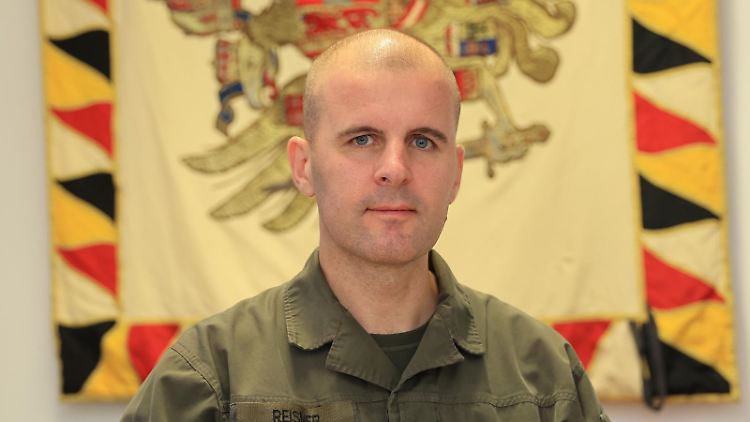As the second wave of Russian air strikes rolls across Ukraine, a cold wave is also sweeping across the country. Ukraine must therefore make decisions to protect its soldiers, says Colonel Markus Reisner. Russia is doing the same thing past Winter: “They are attacking in many places on the front at the same time and are forcing Ukraine to use its regional and strategic reserves.”
ntv.de: The thermometer showed freezing temperatures of up to minus 20 degrees in Ukraine last night. Even during the day it remains frosty with temperatures down to minus 13 degrees. How dangerous are the low temperatures for the Ukrainian soldiers on the front?

Markus Reisner is a colonel in the Austrian armed forces and analyzes the war situation in Ukraine every Monday for ntv.de.
(Photo: private)
Markus Reisner: These are extreme conditions for the soldiers. The low temperatures cause the ground to slowly freeze and the mud season is over. But in these weather conditions it is hardly possible to stay outdoors for a long time, attack or even survive wounded. Both sides must consider how to deal with the new weather conditions. This could also lead to the Ukrainians having to abandon the bridgehead in Krynky on the Dnipro near Kherson because it is not possible to protect the soldiers from the cold or frostbite. General Saluschny has already promised this.
At the bridgehead near Krynky, supplies were only possible by boat across the Dnipro. There is swampland all around. If the water freezes, will they still be able to supply their troops?
Flowing water does not freeze as quickly as standing water. There are already places in the swamps and other areas with water where the water freezes and is passable if the ice cover is thick enough. But mortar and artillery shells can cause this ice sheet to collapse, potentially causing soldiers to fall into the icy water and causing severe frostbite or death from hypothermia to occur very quickly. That is a big problem. It is therefore quite conceivable that Ukraine will make decisions in the interests of the soldiers and give up on things that have not yet proven to be effective. The Russians, in turn, are trying to maintain momentum by launching a new wave of massive strategic airstrikes.
According to the UN, more than 100 civilians have been killed by Russian airstrikes in the past ten days. Is Russia targeting more residential areas this year instead of Ukrainian infrastructure like last winter?
Missed hits are always possible, for example by shooting down an incoming rocket that then comes down in a residential area. If you look at the hits and the massive impacts in civilian areas, you have to say clearly that the Russian side is obviously firing specifically at the civilian population.
Does the Russian side want to kill as many civilians as possible?
Russia is trying to exert terror and bring the population to its knees – with the calculation that a dissatisfied population will then go into opposition to the current Ukrainian government as a result of the air strikes and strongly challenge the Ukrainian government under President Zelensky.
Many Ukrainians are already criticizing the state news channel “Telemarathon” and no longer trust it as much as they did at the beginning of the war of aggression. Are these the first signs of broader discontent among the population?
Individual actions or protests quickly create the image that it is a trend across the country. But you can’t say that. It would be a trend if there were massive protests in various important cities at the same time. But we are far away from that, unfortunately also in Russia. In Ukraine, however, there are isolated and publicly visible opposition efforts. The reason for this is, for example, the intensified recruitment, through which an additional 500,000 soldiers are to be sent to the front. But the population is not rebelling against the Ukrainian government, on the contrary.
The extreme air attacks by the Russians are making calls for delivery of the Taurus cruise missile in Germany louder again. What difference could this make for Ukraine in the current situation?
At the turn of the year, Russia deployed around 500 cruise missiles, ballistic missiles and Iranian drones. The pressure is understandable because the question is: how can Ukraine defend itself? On the one hand, one thinks of the use of anti-aircraft systems. But the Ukrainian government is also trying to counter the attacks by attacking Belgorod and the Russian population. She is also entitled to this under international law in accordance with the right to self-defense. But the resources it uses here are nowhere near as massive as Russia’s. Hence the call for Taurus, which has three very specific advantages as a weapon system. On the one hand, the resistance against possible Russian defensive measures because it flies very low on approach and can move according to the terrain. It also has several systems for navigation. Disturbance systems cannot switch off all of them at the same time.
And the third advantage?
This is the detonator, which, in contrast to Scalp and Storm Shadow, is adjustable, so that you could, for example, take targeted action against large, massive bridges. The Taurus could destroy the support of a bridge, not just make a hole in the bridge deck like Scalp and Storm Shadow. This explains the pressure on the German federal government to deliver these systems.
In Belgorod, hundreds of Russians fled the city after the attacks. Are there any new findings as to which weapons led to the deaths?
Both sides are trying to control the narrative about it. The Ukrainians say the Russians attacked themselves or caused the casualties through their own anti-aircraft defenses and misdirected missiles. The Russians blame the Ukrainians. Most recently they published photos of rocket debris from the RM-70 Vampire. This is a Czech multiple rocket launcher with a range of at least over 20 kilometers that was delivered to Ukraine. It is unclear whether the pictures were actually taken in Belgorod or not. The only way to really know is to conduct an independent on-site investigation.
Why doesn’t Ukraine increase its attacks on Russian territory?
She has few other options. On the one hand, it has a major shortage of ammunition compared to Russia. The ratio is currently around 2,000 artillery shells from the Ukrainian side to 10,000 from the Russian side per day. On the other hand, it lacks the extensive systems that Ukraine demands, such as Taurus or sufficient ATACMS to effectively counter Russian attacks. And the systems it has are being shot down or destroyed by the Russians in very high numbers. An estimated 50 percent of Ukraine’s long-range precision munitions, especially air-to-ground systems, are jammed by the Russians, causing them to go off course or be shot down.
How can Ukraine prevent this?
In the preparation phase before a planned attack, it must specifically switch off Russian radar and defense systems so that its own systems such as Storm Shadow or Scalp can actually penetrate and hit a target.
The focus is currently very much on the Russian attacks inside the country. What about the rest of the front?
At the tactical and operational level, the Russians are trying to do the same thing they tried in the last winter offensive: attacking many parts of the front at the same time and forcing Ukraine to use its regional and strategic reserves. The Russian attacks are devastating. Devastating because in many places the same place is attacked again and again, sometimes with massive losses on the Russian side. The Ukrainian side is on the defensive almost everywhere. They are still trying to hold the bridgehead at Krynky. But videos show that the Russians are beginning to massively use drones to hinder attempts to cross the Dnipro.
Russian forces are also said to be advancing in the north near Kupyansk. Are the Ukrainians being pushed back there?
The Russians have suffered heavy losses there, but are able to slowly work their way forward, meter by meter. The Russian airborne forces are also operating successfully a little south of there in the Bakhmut area. There they managed to undo Ukraine’s successes achieved in the summer. In Avdiivka, Ukraine was able to stabilize the front to the extent that Ukraine brought in significant forces, especially this 47th mechanized brigade, which prevented the Russians from closing the pocket through ongoing counterattacks. The Russians even managed to retake territory north of Mariupol near Robotyne. Terrain that the Ukrainian side had fought for with heavy losses in the summer.
So is the front line shifting back inland in favor of the Russians?
In a marginal way at the moment. About 18 to 19 percent of the country is still occupied, and that hasn’t changed significantly. But Russian troops have retaken territory that Ukraine had only liberated in the summer. Such a war of attrition is primarily determined by the question of resources. At some point the tipping point comes and when it occurs, the situation can suddenly change in favor of one party. Then everything can happen very quickly. Ukraine must therefore try to expand and maintain its defense lines. Then it won’t be possible for the Russians to push through massively.
Vivian Micks spoke to Markus Reisner
